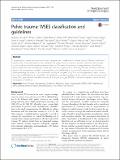| dc.contributor.author | Coccolini, Federico | en_US |
| dc.contributor.author | Stahel, Philip F. | en_US |
| dc.contributor.author | Montori, Giulia | en_US |
| dc.contributor.author | Biffl, Walter | en_US |
| dc.contributor.author | Horer, Tal M | en_US |
| dc.contributor.author | Catena, Fausto | en_US |
| dc.contributor.author | Kluger, Yoram | en_US |
| dc.contributor.author | Moore, Ernest E. | en_US |
| dc.contributor.author | Peitzman, Andrew B. | en_US |
| dc.contributor.author | Ivatury, Rao | en_US |
| dc.contributor.author | Coimbra, Raul | en_US |
| dc.contributor.author | Fraga, Gustavo Pereira | en_US |
| dc.contributor.author | Pereira, Bruno | en_US |
| dc.contributor.author | Rizoli, Sandro | en_US |
| dc.contributor.author | Kirkpatrick, Andrew | en_US |
| dc.contributor.author | Leppaniemi, Ari | en_US |
| dc.contributor.author | Manfredi, Roberto | en_US |
| dc.contributor.author | Magnone, Stefano | en_US |
| dc.contributor.author | Chiara, Osvaldo | en_US |
| dc.contributor.author | Solaini, Leonardo | en_US |
| dc.contributor.author | Ceresoli, Marco | en_US |
| dc.contributor.author | Allievi, Niccolò | en_US |
| dc.contributor.author | Arvieux, Catherine | en_US |
| dc.contributor.author | Velmahos, George | en_US |
| dc.contributor.author | Balogh, Zsolt | en_US |
| dc.contributor.author | Naidoo, Noel | en_US |
| dc.contributor.author | Weber, Dieter | en_US |
| dc.contributor.author | Abu-Zidan, Fikri | en_US |
| dc.contributor.author | Sartelli, Massimo | en_US |
| dc.contributor.author | Ansaloni, Luca | en_US |
| dc.date.accessioned | 2017-02-18T01:58:46Z | |
| dc.date.issued | 2017 | en_US |
| dc.identifier.citation | Coccolini, F., P. F. Stahel, G. Montori, W. Biffl, T. M. Horer, F. Catena, Y. Kluger, et al. 2017. “Pelvic trauma: WSES classification and guidelines.” World Journal of Emergency Surgery : WJES 12 (1): 5. doi:10.1186/s13017-017-0117-6. http://dx.doi.org/10.1186/s13017-017-0117-6. | en |
| dc.identifier.issn | 1749-7922 | en |
| dc.identifier.uri | http://nrs.harvard.edu/urn-3:HUL.InstRepos:30371076 | |
| dc.description.abstract | Complex pelvic injuries are among the most dangerous and deadly trauma related lesions. Different classification systems exist, some are based on the mechanism of injury, some on anatomic patterns and some are focusing on the resulting instability requiring operative fixation. The optimal treatment strategy, however, should keep into consideration the hemodynamic status, the anatomic impairment of pelvic ring function and the associated injuries. The management of pelvic trauma patients aims definitively to restore the homeostasis and the normal physiopathology associated to the mechanical stability of the pelvic ring. Thus the management of pelvic trauma must be multidisciplinary and should be ultimately based on the physiology of the patient and the anatomy of the injury. This paper presents the World Society of Emergency Surgery (WSES) classification of pelvic trauma and the management Guidelines. | en |
| dc.language.iso | en_US | en |
| dc.publisher | BioMed Central | en |
| dc.relation.isversionof | doi:10.1186/s13017-017-0117-6 | en |
| dc.relation.hasversion | http://www.ncbi.nlm.nih.gov/pmc/articles/PMC5241998/pdf/ | en |
| dash.license | LAA | en_US |
| dc.subject | Pelvic | en |
| dc.subject | Trauma | en |
| dc.subject | Management | en |
| dc.subject | Guidelines | en |
| dc.subject | Mechanic | en |
| dc.subject | Injury | en |
| dc.subject | Angiography | en |
| dc.subject | REBOA | en |
| dc.subject | ABO | en |
| dc.subject | Preperitoneal pelvic packing | en |
| dc.subject | External fixation | en |
| dc.subject | Internal fixation | en |
| dc.subject | X-ray | en |
| dc.subject | Pelvic ring fractures | en |
| dc.title | Pelvic trauma: WSES classification and guidelines | en |
| dc.type | Journal Article | en_US |
| dc.description.version | Version of Record | en |
| dc.relation.journal | World Journal of Emergency Surgery : WJES | en |
| dash.depositing.author | Velmahos, George | en_US |
| dc.date.available | 2017-02-18T01:58:46Z | |
| dc.identifier.doi | 10.1186/s13017-017-0117-6 | * |
| dash.authorsordered | false | |
| dash.contributor.affiliated | Velmahos, George | |


